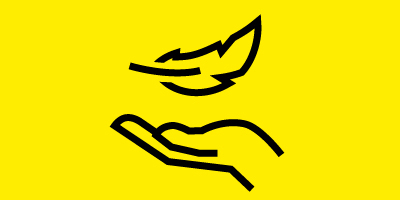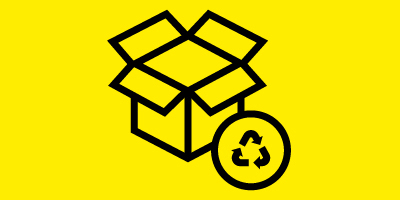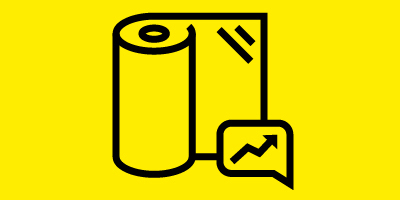Packaging that protects the product and the planet
High-quality packaging ensures our products reach customers safely. Here at Kärcher, however, it's not enough that our packaging just be strong – we believe it should also save resources and be sustainable. And we are working hard to ensure this is the case.

Packaging has several jobs to do – it has to convey important information, attract interest in a product and, of course, protect the product from damage on its journey to the customer. Yet, as soon as all these important jobs are done, the packaging finds itself in the bin. This is why improving product packaging is such an important sustainability goal for Kärcher and one that forms part of our sustainability strategy for 2025.
We have set ourselves the following objectives to be achieved by 2025:
- To keep monitoring and assessing the packaging we are using in terms of its circular economy
- To reduce packaging materials as much as possible
- To improve the recyclability of all packaging
- To discontinue the use of polystyrene in our Home & Garden products
- To use a minimum of 50 per cent recycled content or sustainable alternatives in the plastic bags that protect our products from scratches
- To discontinue use of bubble wrap for shipping spare parts or repaired devices
- To develop and implement new solutions for sustainable packaging in partnership with universities and innovative start-ups
When can packaging be described as sustainable?
The primary job of any packaging is to protect a product from getting damaged while it is in transit to the customer. After all, if the packaging failed on this front, it would be anything but sustainable, since the device would have to be repaired or even completely replaced as a result – not to mention the frustration it would cause customers. That is why we ensure that all our packaging fulfils this fundamental requirement. Frank Kötzle is in charge of packaging development at Kärcher. "With this principle in mind," he explains, "we are pursuing the 'reduce, remove, replace.' strategy to ensure packaging materials are kept to a minimum, dispensed with altogether, or replaced with more sustainable alternatives."


Packaging should be a consideration even at the product design stage
To ensure this is the case, Kötzle and his team are involved in product development right from the start. "It used to be a case of them simply telling us 'Here you go, here's a product. Please package it so that it reaches the customer in one piece.' Which meant we were already on the back foot when it came to focusing on sustainability." But nowadays, product and packaging are viewed as a whole at Kärcher. "We are under no illusions here," Kötzle continues, "and we know full well that all the resources and all the budget that goes into packaging ultimately ends up in the recycling bin. That's why we prefer to invest that money into developing and producing devices that are more stable and robust in the first place. Not only do more robust machines require less protective packaging for transportation, but they also last longer in day-to-day use."
Our Mobile Outdoor Cleaner is a good example of this principle in practice. Previously, the device was protected and held in place in the box by four polystyrene inlays. In order to do away with these, our developers reinforced the product itself, so that the polystyrene inlays were no longer necessary. All that is needed in their place is a single inlay of corrugated cardboard. This has the added benefit of reducing the overall dimensions of the box.
Development without waste
It is not only the outcome of this development work that is sustainable, but also the process itself. Johannes Wöllhaf, a packaging engineer at Kärcher, explains: "Before we even manufacture a physical prototype of a product for new product developments, we create a realistic simulation of the entire transport process." He and his colleagues perform virtual tests, for instance to establish what would happen if the product were to fall off the loading ramp. They also run tests to determine which product and packaging materials work best together in transit. These measures shorten the development process by weeks, because you don't have to keep making new physical prototypes and packaging – which, in turn, also reduces waste. "The simulation results show us exactly what will happen if we were to change the wall thickness of a product's panelling, for example, or how well protected a product is if we were to make the packaging thinner, change the material or even do away with it entirely."
Virtual development also facilitates international collaboration, since results can be shared quickly and easily with colleagues in different countries. This collaboration is important, as it allows us to share effective solutions for sustainable packaging with colleagues at other locations in a targeted manner. Kötzle explains that this international dimension does also have its challenges: "What constitutes 'sustainable' is always viewed slightly differently in every country and every region of the world. Plastic bags, for example, are not considered particularly sustainable in Germany or other European countries. In China and other Asian countries, however, they view things slightly differently. And while there may be some logic to this based purely on CO₂ emissions, it ignores the major problems of plastic pollution in the natural environment and also disregards how difficult they are to recycle. This one example just goes to show that you can arrive at different evaluations of how sustainable or unsustainable something is depending on whether you focus on emissions, waste generation, water consumption or other factors. That is why we are currently working together with Sustainability Management, Product Management and Purchasing to introduce a uniform Kärcher standard that applies worldwide, incorporating minimum requirements for the sustainability of packaging."
(In the picture from left to right: Johannes Wöllhaf and Frank Kötzle)



Stepping away from polystyrene
It is also important to us that packaging material is as environmentally friendly as possible. That is why we have been reducing the amount of polystyrene over the years and are turning to environmentally friendly alternatives. As of 2022, we have ceased the use of polystyrene inlays in any new developments of our Home & Garden products. Our teams of packaging experts are pursuing alternative routes, with materials such as cardboard, paperboard or pulp proving popular options. We also use packaging materials that are less conventional, including inlays made from pea starch for example. The material is a waste product of the food industry and is completely biodegradable. Since autumn 2023, we have been using pea starch to package all our SC 3 Upright EasyFix steam cleaners in the EU. This switch alone cuts our polystyrene use by 3.2 tonnes per year.
Far-reaching effects
No matter how much we reduce packaging, we still have to have it. That's why we design our packaging so that it can be easily recycled later on. In concrete terms, this means minimising the number of different materials used in each packaging. This makes it easier for customers to dispose of packaging in the right bins. If, however, there is no avoiding multiple materials in the packaging, we make sure that those different materials can easily be separated from each other. We are also using more and more recycled materials for our packaging. 93 per cent of the packaging materials used are already paper-based and consist of at least 80 per cent recycled paper.
We also make sure that we keep our packaging as small as possible. That way, more products fit onto a lorry or into a container, which in turn reduces the carbon footprint of transporting goods. We also use a trick that is as simple as it is ingenious: our packaging is designed so that it can also be used as shipping packaging. We simply stick on an address label and it's ready to go. This means there is no need for extra packaging around the packaging.
Always open to new ideas
In the coming years, we will keep reviewing and adjusting the sustainability objectives for our packaging to reflect new developments. "One final important principle of our work is to 'think outside the box' – if you'll pardon the pun. We are always working to find new ways forward," explains Kötzle. For example, Kärcher is joining forces with start-up company Proservation to develop a sustainable alternative to polystyrene, which uses the husks of cereal grains as its basis. The husks are a byproduct of grain production local to Proservation, and are not ordinarily put to any further use. We are supporting Proservation in developing the inlays further and in exploring their potential for industrial applications. The first prototypes have already been put to the test in our laboratory.
Who knows what the packaging team will come up with next in terms of sustainable packaging? All we know is that our experts will pull out all the stops to achieve the objectives by 2025 and then keep working on new projects – making our packaging even more sustainable one step at a time.


Reducing the weight of polystyrene inlays
Product:
Various pressure washers in the compact class
Adaptation:
Reducing the weight of the polystyrene inlays inside the box that protect the pressure washer during transit.
Sustainability impact:
Plastic use cut by 7920 kilograms per year

Switching from polystyrene inlays to pulp inlays
Product:
FC 7
Adaptation:
The previous EPS (polystyrene) inlays have been replaced with inlays made from recyclable pulp
Sustainability impact:
Plastic use cut by approx. 33 tonnes per year and packaging now fully recyclable

Cardboard inlays instead of polystyrene inlays
Product:
K4 pressure washers produced at the Bühlertal plant
Adaptation:
Replacing the polystyrene inlays in the box with corrugated cardboard inlays
Sustainability impact:
Polystyrene use cut by 10,000 kilograms per year

Optimising plastic stretch film
Product:
Stretch film
Adaptation:
Reducing the thickness of the film while maintaining the same cargo-securing properties
Sustainability impact:
Reducing material thickness and optimising the stretch line in the German plants has cut plastic use by on average 60% or approx. 200 tonnes per year.




